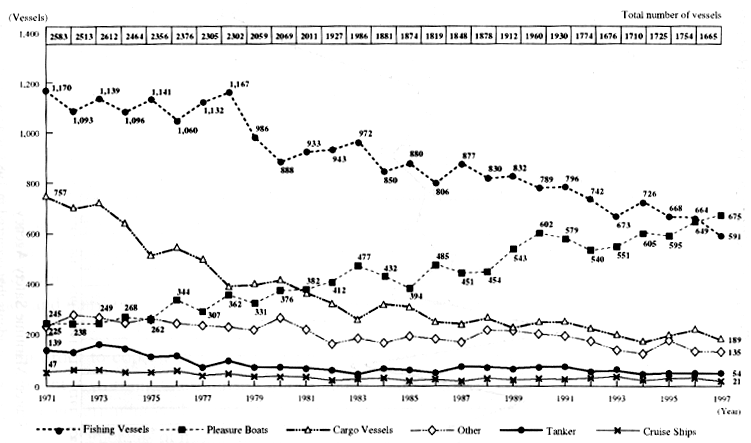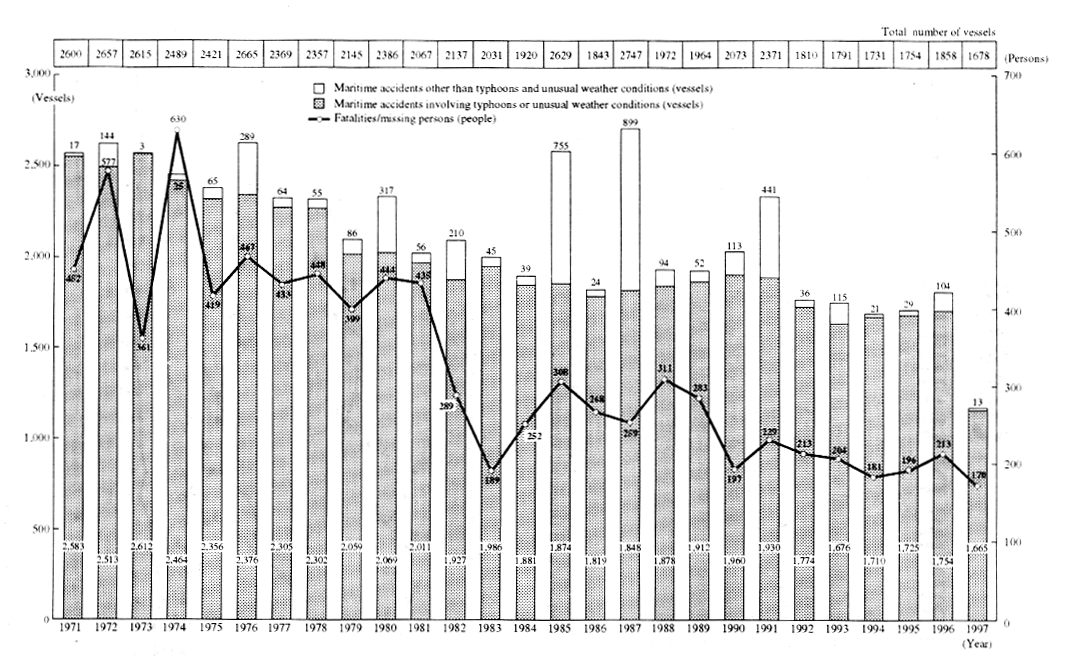
The number of vessels requiring assistance as a result of maritime accidents, excluding those due to typhoons and unusual weather, is declining overall. The most marked reduction was in accidents involving fishing vessels and cargo vessels.
On the other hand, as marine recreational activities have increased in recent years, the number of pleasure boats requiring assistance as the result of maritime accidents has grown. In 1997 such boats accounted for 40.5% of the total (675 vessels), exceeding the figure for fishing vessels and representing the largest single category (Fig. 16).
The number of death or missing persons as a result of maritime accidents has hovered around 200 in recent years, but in 1997 the figure was 170 (Fig. 17).
Figure 16 Changes in Vessels Requiring Assistance by Type of Vessel (Excluding Typhoons and Unusual Weather)

Source: Maritime Safety Agency
Figure 17 Changes in Vessels Requiring Assistance, Fatalities and Missing Persons

Notes:
1. Maritime Accidents Involving Pleasure Boats
Maritime accidents involving pleasure boats have become more numerous every year as marine recreational activities have grown in popularity and ownership of motorboats and yachts has increased (from 371,000 at the end of FY 1992 to 427,000 at the end of FY 1996). In 1997, for the first time, the number of accidents involving pleasure boats exceeded the number of fishing vessels to take the number one position.
Looking at the 1997 figures by type of vessel, 463 (68.6%) were motorboats, 92 (13.6%) were yachts, 48 (7.1%) were recreational fishing vessels, 46 (6.8%) were jet skis, and 26 (3.9%) were rowboats. The number of motorboats has increased relative to five years before. Looking at accidents by cause of maritime accidents, 154 (22.8%) were due to errors in the operation of machinery, 106 (15.7%) were due to negligence, 80 (11.9%) were due to improper handling of vessel, and 71 (10.5%) were due to failure to monitor weather or sea conditions, meaning that 80.1% of all pleasure boat accidents were due to human error. When compared with fishing vessels, the high proportion of accidents attributable to errors in the operation of machinery and failure to monitor weather or sea conditions indicates a lack of basic knowledge and skills.
2. Safety Measures for Pleasure Boats
The government is promoting the development of "Fisharinas" at fishing ports and marinas to serve as bases for the safe operation of pleasure boats. Furthermore, the government is working to improve rescue systems by strengthening patrol vessels and aircraft rescue systems and promoting the development of private sector search and rescue systems.
In order to permit the timely and accurate receipt of accident-related and other information, the government is working to establish an emergency reporting system for maritime satellite telephones and maritime cellar phones, and to promote the wider use of maritime leisure radio equipment.
In order to cope with the increasing diversity of pleasure boat design and operation, the government is working to establish safety standards and a system of inspections for small vessels.
The government is also working to make pleasure boat enthusiasts aware of maritime traffic rules, the fundamentals of maritime weather and other basic information needed to navigate safely, and provides assistance to private groups conducting their own safety activities. At the same time, the government is developing systems to collect, manage and distribute maritime information that will contribute to safe marine recreational activities, and working to develop policies for the distribution of such information.
In addition to promoting the development of breakwaters, waterways, berths and mooring facilities at ports and harbors and fishing ports, the government is also promoting the development of beacons or channel marks, shelter ports and waterways designated to be developed and preserved.
In order to improve earthquake resistance at ports and harbors and fishing ports, the government is developing earthquake-resistant wharfs, emergency bases and shipping facilities.
The government has introduced special rules that apply to traffic congested areas and is establishing and operating the Maritime Traffic Information System, a unified system combining information dissemination and navigation control for maritime traffic. It is also working to improve weather information and notices to mariners, and to develop maritime charts and nautical publications.
The International Safety Management (ISM) code, which provides a system for safety management of ships, became mandatory as a result of amendments to the International Convention for the Safety of Life at Sea (the SOLAS treaty). Japanese domestic law is therefore being revised and a maritime safety investigation system being consolidated.
As far as Port State Control (supervision by the government of the port-of-call in addition to the government of the national registry) is concerned, the government is extending the scope and content of supervision and deploying full-time inspectors in order to strengthen the system.
Additionally, because hull deterioration was the cause of the major oil spill by the Nakhodka, the government proposed to the International Maritime Organization (IMO) that additional items be included in an inspection report serial, and that notification system be improved in order to strengthen international Port State Controls relating to the structural integrity of vessels. Some aspects of these proposals were accepted.